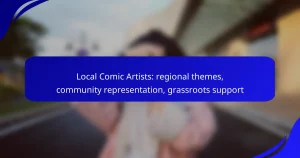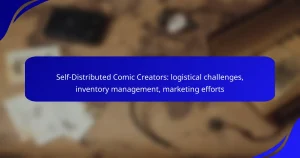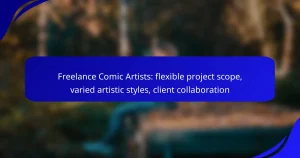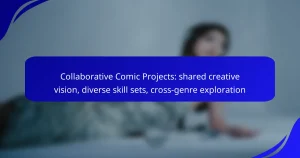Exploring the world of comic creators reveals a vibrant community driven by creativity and innovation. From mastering artistic techniques to navigating diverse revenue streams, aspiring creators can find numerous pathways to success. By understanding the tools of the trade and the intricacies of storytelling, they can effectively engage audiences and bring their unique visions to life.
Local Comic Artists: regional themes, community representation, grassroots support
Local comic artists play a vital role in reflecting the unique themes and stories of their communities, using storytelling and visual styles that resonate with regional audiences. Through grassroots support…
Comic Scriptwriters: narrative structure, dialogue crafting, pacing techniques
Comic scriptwriters play a crucial role in shaping narratives through structured frameworks that enhance storytelling. By utilizing techniques for crafting authentic dialogue and managing pacing, they create engaging and dynamic…
Comic Illustrators: visual storytelling, character design, panel layout
Comic illustrators master the art of visual storytelling by skillfully blending narrative techniques with artistic elements. Through thoughtful character design, vibrant color palettes, and strategic panel layouts, they create engaging…
Zine Comic Artists: material costs, distribution reach, audience awareness
Zine comic artists face varying material costs influenced by printing methods, paper quality, and distribution choices, making it essential to budget effectively for sustainability. By leveraging online platforms, local shops,…
Webcomic Creators: accessible storytelling, regular updates, interactive audience
Webcomic creators have the unique opportunity to enhance storytelling through visual elements and character development, creating a compelling narrative that resonates with readers. By implementing structured planning and utilizing tools…
Comic Anthology Contributors: submission guidelines, editorial feedback, thematic consistency
Contributors to the comic anthology must follow specific submission guidelines, which include details on formatting, length, and deadlines to ensure their work is properly evaluated. Editorial feedback will be provided…
Comic Anthology Contributors: collective storytelling, varied perspectives, thematic diversity
Comic anthologies serve as a vibrant platform for collective storytelling, uniting diverse creators to share their unique narratives. By weaving together varied perspectives and thematic diversity, these collections enrich the…
Online Comic Platforms: wider audience access, monetization options, reader feedback
Online comic platforms offer creators the opportunity to reach a wider audience through digital distribution and social media integration, while also catering to diverse reader needs with multilingual and accessibility…
Local Comic Artists: regional limitations, audience size, promotional opportunities
Local comic artists face unique challenges due to regional limitations, but they can effectively expand their reach by utilizing digital tools and engaging with their communities. The size of their…
Collaborative Comic Projects: shared creative vision, diverse skill sets, cross-genre exploration
Collaborative comic projects bring together diverse creatives to share a unified vision, leveraging their unique skills to enhance storytelling. By exploring cross-genre themes, these collaborations not only broaden artistic expression…
How do comic creators earn income?
Comic creators earn income through various channels, including direct sales, crowdfunding, and digital platforms. Understanding these revenue streams can help creators maximize their earnings and reach a wider audience.
Sales from comic books
Sales from comic books are a primary source of income for many creators. This can include physical copies sold in stores or online, as well as digital versions. Creators often receive a percentage of the sales, which can vary based on their publishing agreements.
Independent creators might sell their comics at conventions or through their own websites, allowing for higher profit margins. Pricing typically ranges from a few dollars for digital comics to over twenty dollars for physical editions, depending on the format and production quality.
Crowdfunding through platforms like Kickstarter
Crowdfunding is a popular method for comic creators to finance their projects before they are completed. Platforms like Kickstarter allow creators to set funding goals and offer rewards to backers, such as exclusive content or signed copies.
Successful campaigns can raise thousands of dollars, but they require careful planning and marketing. Creators should consider their audience and set realistic funding goals, often aiming for amounts that cover production costs and provide a buffer for unexpected expenses.
Merchandising and licensing
Merchandising and licensing can significantly boost a comic creator's income. This includes selling branded merchandise like t-shirts, posters, and collectibles, as well as licensing characters or stories for use in other media.
Creators can partner with manufacturers or use print-on-demand services to minimize upfront costs. Licensing deals can be lucrative but often require negotiation skills and an understanding of intellectual property rights.
Patreon subscriptions
Patreon subscriptions provide a steady income stream for comic creators by allowing fans to support them on a monthly basis. In exchange, creators offer exclusive content, behind-the-scenes access, or early releases to their subscribers.
This model fosters a closer relationship with fans and can lead to a more stable financial situation. Creators should regularly engage with their patrons and deliver promised rewards to maintain subscriber loyalty.
Digital content sales on platforms like ComiXology
Digital content sales on platforms like ComiXology enable creators to reach a global audience without the overhead of physical distribution. These platforms often take a percentage of sales, but they provide valuable exposure and access to a dedicated comic-reading audience.
Creators should consider pricing strategies that reflect the digital market, typically ranging from $0.99 to $9.99 per issue. Regular updates and new releases can help maintain visibility and attract new readers on these platforms.
What tools do comic creators use?
Comic creators utilize a variety of tools to bring their stories to life, ranging from traditional materials to advanced digital software. The choice of tools often depends on the creator's style, budget, and the specific requirements of their projects.
Adobe Creative Suite for digital art
Adobe Creative Suite, particularly Photoshop and Illustrator, is widely used for digital art in comics. These programs offer powerful features for illustration, coloring, and layout, making them suitable for both beginners and professionals.
Photoshop excels in raster graphics, allowing artists to create detailed images with various brushes and effects. Illustrator, on the other hand, is ideal for vector graphics, which can be scaled without losing quality. Many comic artists use both to leverage their unique strengths.
Clip Studio Paint for comic creation
Clip Studio Paint is specifically designed for comic creation, offering tools tailored for panel layouts, inking, and coloring. Its user-friendly interface and extensive brush options make it a favorite among comic artists.
This software includes features like 3D models for reference, perspective rulers, and customizable brushes, which streamline the comic-making process. It's particularly popular for manga and webcomics, providing a range of templates and tools to enhance productivity.
Procreate for iPad drawing
Procreate is a powerful drawing app for the iPad, favored for its intuitive touch interface and extensive brush library. It allows artists to create high-quality illustrations on the go, making it a popular choice for sketching and final artwork.
With features like layering, blending modes, and animation tools, Procreate caters to both casual doodlers and professional illustrators. Its affordability compared to desktop software makes it accessible for many aspiring comic creators.
Wacom tablets for illustration
Wacom tablets are a staple in the comic creation industry, providing a natural drawing experience that mimics traditional pen and paper. These tablets come in various sizes and models, catering to different preferences and budgets.
Using a Wacom tablet allows for precise control over brush strokes and pressure sensitivity, which is crucial for detailed illustrations. Many artists pair these tablets with software like Adobe Creative Suite or Clip Studio Paint for optimal results.
How can aspiring comic creators get started?
Aspiring comic creators can begin by honing their artistic skills and understanding storytelling techniques. Developing a unique style and voice is crucial, as is familiarizing oneself with the comic industry and its audiences.
Building a portfolio of work
Creating a portfolio is essential for showcasing your skills and style. Include a variety of pieces, such as character designs, short comics, and illustrations, to demonstrate your versatility. Aim for a collection of around 5-10 polished works that reflect your best abilities.
Consider using platforms like Behance or personal websites to display your portfolio. Regularly update your portfolio as you create new work to keep it fresh and relevant.
Networking with other creators
Networking with fellow comic creators can open doors to collaboration and mentorship opportunities. Attend local art meetups or join online forums where creators share tips and feedback. Building relationships in the industry can lead to valuable insights and connections.
Engage with creators on social media platforms like Twitter or Instagram, where many artists share their work and experiences. Don’t hesitate to reach out for advice or to discuss projects; most creators appreciate genuine interest.
Participating in comic conventions
Comic conventions are excellent venues for aspiring creators to showcase their work and meet industry professionals. Look for local or regional conventions where you can set up a booth or participate in artist alleys. This exposure can help you gain feedback and build a fanbase.
Prepare promotional materials such as business cards or mini-comics to distribute at these events. Engaging with attendees and other artists can lead to future collaborations and opportunities.
Joining online communities like Webtoon
Online platforms like Webtoon provide a space for comic creators to publish their work and reach a wider audience. Joining such communities allows you to share your comics, receive feedback, and connect with readers who appreciate your genre.
Participate actively by commenting on others' work and engaging in discussions. This interaction can help you build a following and gain insights into what resonates with audiences.
What are the major comic conventions in the US?
The major comic conventions in the US are significant events where fans, creators, and industry professionals gather to celebrate comic culture. These conventions feature panels, signings, merchandise, and networking opportunities, making them essential for anyone involved in the comic industry.
San Diego Comic-Con
San Diego Comic-Con (SDCC) is the largest and most renowned comic convention in the United States, typically held in July. It attracts hundreds of thousands of attendees and features a wide array of panels, workshops, and exclusive merchandise. For creators, it's an excellent opportunity to network with publishers and showcase their work.
Attendees should plan ahead, as tickets sell out quickly, and accommodations in San Diego can be expensive. Arriving early can help secure a good spot for popular panels and events.
New York Comic Con
New York Comic Con (NYCC) is another major event, usually taking place in October. It offers a vibrant mix of comic book culture, anime, gaming, and pop culture. The convention hosts numerous panels featuring industry leaders, as well as opportunities for creators to meet fans and other professionals.
Tickets for NYCC can also sell out rapidly, so it's advisable to purchase them as soon as they become available. The convention is held at the Jacob K. Javits Convention Center, which is conveniently located near public transportation.
Emerald City Comic Con
Emerald City Comic Con (ECCC), held annually in Seattle, is known for its focus on comic books and graphic novels. This convention typically occurs in March and features a more intimate atmosphere compared to larger events. It provides a platform for indie creators to showcase their work alongside established artists.
Attendees appreciate the diverse programming, including workshops and panels that cater to various interests. Booking accommodations early is recommended due to the event's popularity and the limited availability of hotels in the area.
WonderCon
WonderCon, held in Anaheim, California, is a smaller yet significant convention that usually takes place in spring. It features a mix of comic book content, anime, and pop culture, appealing to a broad audience. The event is known for its friendly atmosphere and accessibility for both fans and creators.
For those considering attending, it's a great opportunity to engage with creators in a more personal setting. As with other conventions, securing tickets and accommodations early is wise to avoid last-minute issues.
What are the trends in comic creation today?
Current trends in comic creation highlight the growing influence of digital platforms and the increasing diversity in storytelling. Creators are leveraging technology to reach wider audiences while also embracing varied narratives that reflect a broader range of experiences.
Rise of webcomics and digital platforms
The rise of webcomics has transformed how comics are created and consumed. Platforms like Webtoon and Tapas allow creators to publish their work online, often for free, enabling them to build a following without traditional publishing barriers.
Digital platforms offer various monetization options, such as subscription models and crowdfunding through sites like Patreon. This flexibility allows creators to earn income while maintaining creative control over their work.
Diversity in storytelling and representation
Diversity in storytelling is increasingly prominent in the comic industry, with creators from various backgrounds sharing their unique perspectives. This shift not only enriches the narrative landscape but also attracts a broader audience seeking representation in the stories they consume.
Readers are now more likely to find comics that explore themes related to race, gender, and sexuality. This trend encourages creators to experiment with different genres and styles, fostering a more inclusive environment in comic creation.






